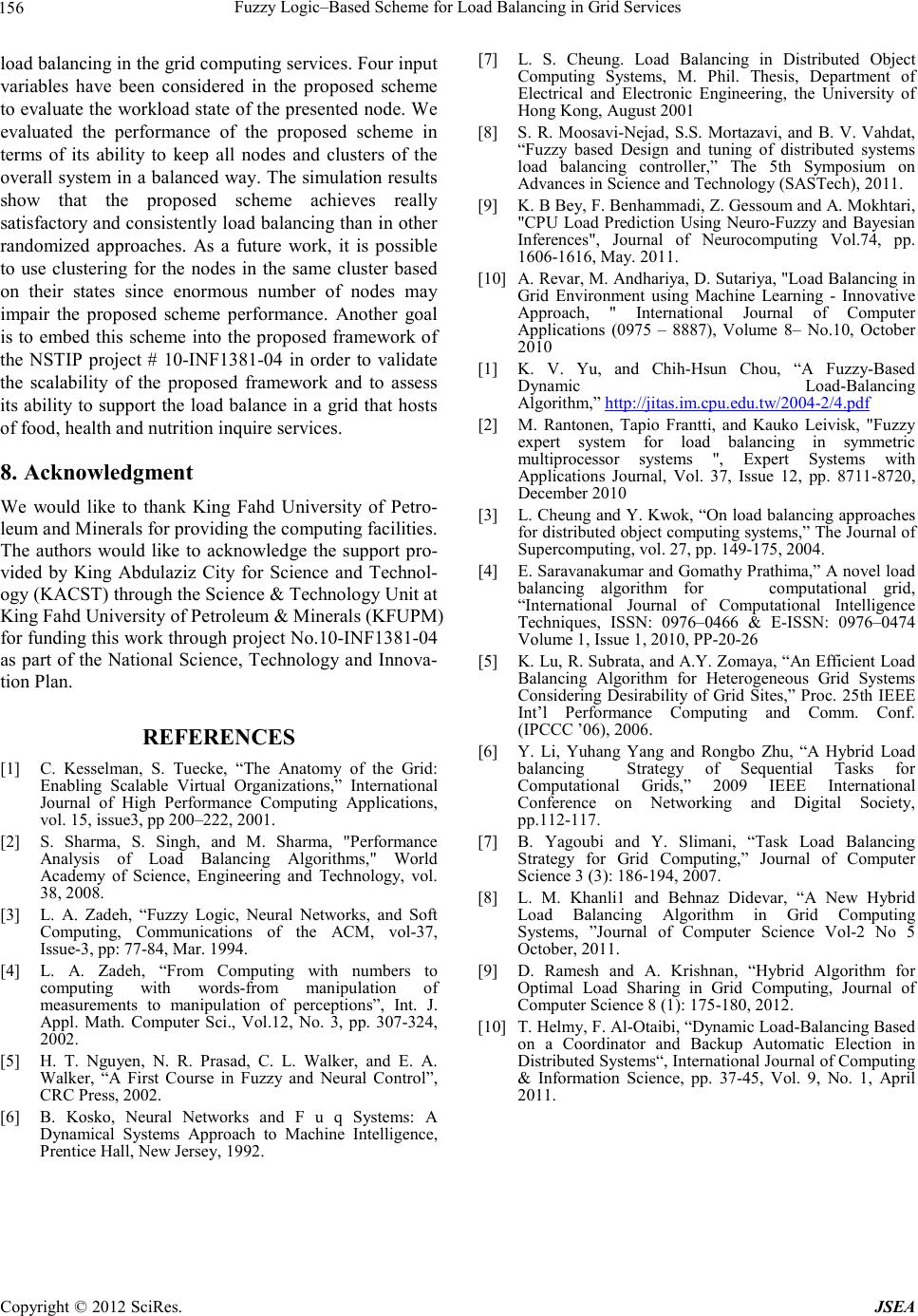
Fuzzy Logic–Based Scheme for Load Balancing in Grid Services
Copyright © 2012 S ciRes. JSEA
156
load balancing in the gr id comput in g services. Four input
variables have been considered in the proposed scheme
to evaluate the workload state of the presented node. W e
evaluated the performance of the proposed scheme in
terms of its ability to keep all nodes and clusters of the
overall system in a balanced way. The simulation res ult s
show that the proposed scheme achieves really
satisfactory and consistently load balancing than in other
randomized approaches. As a future work, it is possible
to use clustering for the nodes in the same cluster based
on their states since enormous number of nodes may
impair the proposed scheme performance. Another goal
is to embed this sch eme into the proposed framework of
the NSTIP project # 10-INF1381-04 in order to validate
the scalability of the proposed framework and to assess
its ability to support the load balance in a grid that hosts
of food, health and nutrition inquire services.
8. Acknowledgment
We would like to thank King Fahd University of Petro-
leum and Minerals for providing the computing faci lities.
The authors would like to acknowledge the support pro-
vided by King Abdulaziz City for Science and Technol-
ogy (KACST ) thr o ug h the Sc i e nce & T e chno log y Unit at
King F ahd University of Petroleum & Minerals (KFUPM)
for funding this work through project No.10-INF1381-04
as part of the National Science, Technology and Innova-
tion Plan.
REFERENCES
[1] C. Kesselman, S. Tuecke, “The Anatomy of the Grid:
Enabling Scalable Virtual Organizations,” International
Journal of High Performance Computing Applications,
vol. 15, iss ue3, pp 200–222, 2001.
[2] S. Sharma, S. Singh, and M. Sharma, "Performance
Analysis of Load Balancing Algorithms," World
Academy of Science, Engineering and Technology, vol.
38, 2008 .
[3] L. A. Zadeh, “Fuzzy Logic, Neural Networks, and Soft
Computing, Communications of the ACM, vol-37,
Issue-3, pp: 77-84, Mar. 1994.
[4] L. A. Zadeh, “From Computing with numbers to
computing with words-from manipulation of
measurements to manipulation of perceptions”, Int. J.
Appl. Math. Computer Sci., Vol.12, No. 3, pp. 307-324,
2002.
[5] H. T. Nguyen, N. R. Prasad, C. L. Walker, and E. A.
Walker, “A First Course in Fuzzy and Neural Control”,
CRC Press, 2002.
[6] B. Kosko, Neural Networks and F u q Systems: A
Dynamical Systems Approach to Machine Intelligence,
Prent ice Hall, New Jersey, 1992.
[7] L. S. Cheung. Load Balancing in Distributed Object
Computing Systems, M. Phil. Thesis, Department of
Electrical and Electronic Engineering, the University of
Hong Kong, August 2001
[8] S. R. Moosavi-Nejad, S.S. Mortazavi, and B. V. Vahdat,
“Fuzzy based Design and tuning of distributed systems
load balancing controller,” The 5th Symposium on
Advances in Science and Technology (SASTech), 2011.
[9] K. B Bey, F. Benhammadi, Z. Gessoum and A. Mokhtari,
"CPU Load Prediction Using Neuro-Fuzzy and Bayesian
Inferences", Journal of Neurocomputing Vol.74, pp.
1606-1616, May. 2011.
[10] A. Revar, M. And hari ya, D. Sutariya, "Load Balanci ng in
Grid Environment using Machine Learning - Innovative
Approach, " International Journal of Computer
Applications (0975 – 8887), Volume 8– No.10, October
2010
[1] K. V. Yu, and Chih-Hsun Chou, “A Fuzzy-Based
Dynamic Load-Balancing
Algorithm,” h ttp://jitas.im.cpu.edu.tw/2004-2/4.pdf
[2] M. Rantonen, Tapio Frantti, and Kauko Leivisk, "Fuzzy
expert system for load balancing in symmetric
multiprocessor systems ", Expert Systems with
Applications Journal, Vol. 37, Issue 12, pp. 8711-8720,
December 2010
[3] L. Cheung and Y. Kwok, “On load balancing approaches
for distributed object computing systems,” The Journal of
Supercomputing, vol. 27, pp. 149-175, 20 04.
[4] E. Saravanakumar and Go mathy P rathima,” A novel l oad
balancing algorithm for computational grid,
“International Journal of Computational Intelligence
Techniques, ISSN: 0976–0466 & E-ISSN: 0976–0474
Volume 1, Issue 1, 2010, PP-20-26
[5] K. Lu, R. Subrata, and A.Y. Zomaya, “An Efficient Load
Balancing Algorithm for Heterogeneous Grid Systems
Considering Desirability of Grid Sites,” Proc. 25th IEEE
Int’l Performance Computing and Comm. Conf.
(IPCCC ’06), 2006.
[6] Y. Li, Yuhang Yang and Rongbo Zhu, “A Hybrid Load
balancing Strategy of Sequential Tasks for
Computational Grids,” 2009 IEEE International
Conference on Networking and Digital Society,
pp.112-117.
[7] B. Yagoubi and Y. Slimani, “Task Load Balancing
Strategy for Grid Computing,” Journal of Computer
Science 3 (3): 186 -194, 2007.
[8] L. M. Khanli1 and Behnaz Didevar, “A New Hybrid
Load Balancing Algorithm in Grid Computing
Systems, ”Journal of Computer Science Vol-2 No 5
October, 2011.
[9] D. Ramesh and A. Krishnan, “Hybrid Algorithm for
Optimal Load Sharing in Grid Computing, Journal of
Computer Science 8 (1): 175-180, 2012.
[10] T. Helmy, F. Al-Otai bi , “Dynamic Load -Bal anci ng Based
on a Coordinator and Backup Automatic Election in
Distributed Systems“, International Journal of Computing
& Information Science, pp. 37-45, Vol. 9, No. 1, April
2011.